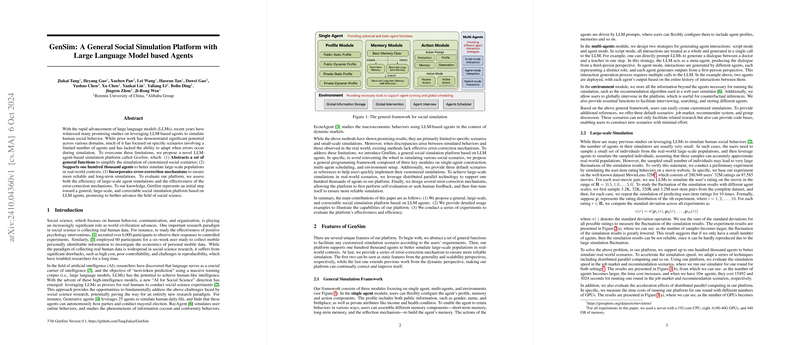Evaluation and Implications of the GenSim Social Simulation Platform
The paper introduces GenSim, an innovative platform for social simulations employing LLM agents. Developed in response to the limitations of previous social simulation studies that could only accommodate a restricted number of agents and lacked robust error-correction mechanisms, GenSim seeks to offer a comprehensive solution that overcomes these barriers. The paper presents GenSim as a significant evolution in LLM-based simulations, with a focus on generalizability, scalability, and self-correction.
The architecture of GenSim is structured around a general simulation framework consisting of three core modules: single-agent construction, multi-agent interaction scheduling, and environment setup. The single-agent module offers users flexibility in configuring agent profiles, memory, and action components, supporting complex agent configurations with elements like short-term and long-term memory. The multi-agent module presents distinct strategies for interaction generation, either using a script mode or an agent mode, to facilitate realistic interactions. The environment module is designed to manage all external information pertinent to simulations while supporting user interventions for specific analyses.
A key highlight of GenSim is its capacity to support up to one hundred thousand agents, marking a significant advancement in simulating large-scale social behaviors compared to existing frameworks. The ability to simulate such expansive populations enables more accurate representations of real-world dynamics by reducing the fluctuations in results typical of smaller-scale studies. The paper outlines empirical evidence demonstrating the stabilization of simulation outputs with increasing agent numbers, evidenced by decreased variability in user-movie rating experiments as the sampled population size increased.
Furthermore, GenSim incorporates error-correction mechanisms to address deviations and unexpected outcomes in simulations, an aspect often neglected by previous studies. Users can leverage these mechanisms either through GPT-4o-based autonomous corrections or through manual human interventions. Fine-tuning techniques such as Proximal Policy Optimization (PPO) and Supervised Fine-Tuning (SFT) on the revised simulation outcomes aim to enhance the accuracy and reliability of subsequent simulation rounds. The authors provide quantitative evidence indicating the positive impact of these mechanisms, noting improvements in simulation performance across iterative rounds.
The implications of GenSim are multifaceted. Practically, by offering a scalable, correctable platform, GenSim can significantly enhance the capability of researchers to conduct complex social science experiments virtually. This could alleviate the traditional burdens—like high cost and poor reproducibility—associated with collecting real-world social data. Theoretically, the paper suggests that LLM-based simulations with such expansive capabilities herald a new approach within AI that better approximates real human behaviors and interactions. Future developments may enhance GenSim through improved acceleration strategies for simulations and more sophisticated error-correction mechanisms, which could further refine these artificial behavioral models.
In conclusion, GenSim contributes a versatile, large-scale, and correctable platform to the field of LLM-based social simulation research. Its architectural design, scalability, and self-correcting features represent meaningful advancements that offer practical solutions to problems that have long hindered the field, while opening up avenues for future research innovations.
